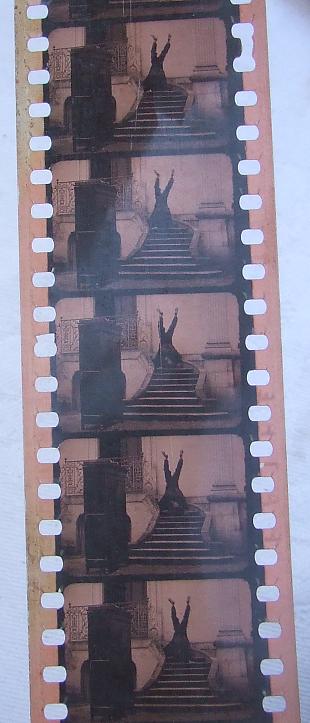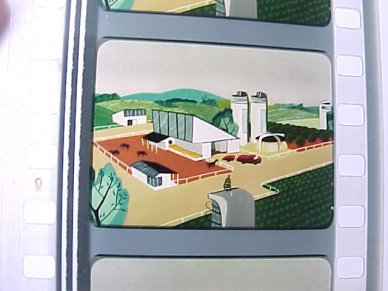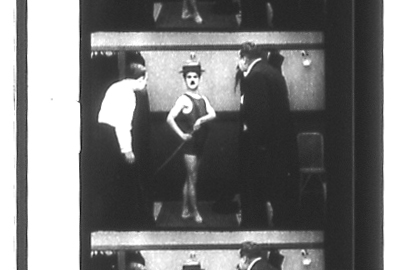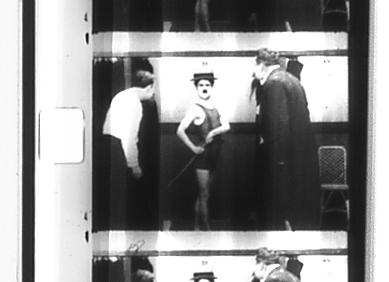This is topic Off-Center Prints in forum 8mm Forum at 8mm Forum.
To visit this topic, use this URL:
https://8mmforum.film-tech.com/cgi-bin/ubb/ultimatebb.cgi?ubb=get_topic;f=1;t=003845
Posted by Mike Tynus (Member # 1108) on July 10, 2008, 06:57 PM:
Hello everyone,
I was wondering why there are occasional Blackhawk prints where the film frame is printed off center? I have 2 sound copies of Chaplin's THE CURE that both have the image moved to the left of frame leaving a chunk of black on the right side, rendering almost a square image. I also have a sound print of WAY DOWN EAST where all 6 reels are also to the left of screen. Yet the Blackhawk intro titles seem fine, leaving me to believe that the copy isn't defective, but something was up with the preprint material. Any info would be appreciated. Thanks!
Posted by Osi Osgood (Member # 424) on July 10, 2008, 10:37 PM:
Could they have been wanting to preserve the original nearly square image?
But then, it seems like they would have centered it squarely.
They were ones for detail.
Posted by Mike Tynus (Member # 1108) on July 11, 2008, 12:47 PM:
Osi,
Thanks for the input. What you say makes perfect sense as when I watch these films it never seems like anything is missing or getting cut off. And yes, Blackhawk was such a caring company. Wondering if anyone else has seen this.
Posted by Tony Stucchio (Member # 519) on July 11, 2008, 06:33 PM:
There is a great article in the December 1975 issue of the Blackhawk bulletin that describes why they did this to the recently restored Chaplin Mutuals. I think David Shepard wrote the article. In a nutshell, it was to restore the original full-frame image, which was bigger before the advent of soundtracks being added to film.
Posted by Kevin Faulkner (Member # 6) on July 11, 2008, 06:37 PM:
If you look at these non centered prints off the projector do they still look off centre. In other words if you look at the film frames with a magnifying glass.
I have seen one or two projectors where the gate runners have not been setup perfectly which means the film is projected slightly to one side.
Have you tried these "off center" prints through another machine to see if they are the same? and what projector are you using?
Kev.
Posted by Tony Stucchio (Member # 519) on July 11, 2008, 06:50 PM:
No, Blackhawk did this on purpose. What I don't understand is if the picture in the silent days was wider since you didn't have to leave room for the soundtrack, wouldn't preserving the entire image have to be done in letterbox format rather than bars at the side of the pic?
Posted by Osi Osgood (Member # 424) on July 11, 2008, 08:10 PM:
No, the silent film ratio WAS an almost perfect square, so cropping the sides would preserve the original aspect ratio.
Well done Blackhawk!
Posted by Mike Tynus (Member # 1108) on July 12, 2008, 02:48 AM:
I ran these films through an S940, ST1200 and GS1200 with the same results.
That's great info concerning the 1975 Blackhawk article. That makes these off center prints all the more fascinating to watch now. And to think that the DVD copies are probably lobbing off the top and bottom of the frame! Thanks for all the input.
Posted by Kevin Faulkner (Member # 6) on July 12, 2008, 10:21 AM:
At least it's consistent between machines. As others have said it's obviously down to Blackhawk preserving the original. Fascinating ![[Smile]](smile.gif)
Kev.
Posted by Bill Brandenstein (Member # 892) on July 14, 2008, 01:11 PM:
Well guys, I don't agree. The "nearly square" image can't be from soundtrack cropping, because my own ruler confirms what is given at this Wikipedia link, that the full-frame area is approximately 19x25mm. This yields an aspect ratio of about 1.3:1. Here's an example:

Bear in mind, and I know most of you know this, that the thick frame lines common to most theatrical releases in the 30s-early 50s (when 'scope called for the use of the full frame height again) was due to preserving a 1.33:1 ratio after the soundtrack stole some of the width.

I hope that cinematographers have correct framing marks in their viewfinders when cropping is done like this:

Well, my 2c is that Blackhawk made an error, whether just sloppy or due to a mistaken assumption concerning the aspect ratio.
I had to file out the Std 8 aperture window for my Eumig 810D because it covered up the left side of the picture, initially making it nearly square. Maybe Blackhawk had a conspiracy going with Eumig!
Posted by Claus Harding (Member # 702) on July 14, 2008, 06:53 PM:
"Academy" framing then and later...1:1.33 was the original silent matte, 1:1.37, as I recall (please correct me if this is wrong) was the later aspect when the soundtrack needed space, so the image got a bit wider due to the top/bottom getting trimmed.
In Blackhawk's Super-8 version of 'Nosferatu' you are treated to a variety of aspect ratios, including the classic 'almost square' silent matte.
Claus.
Posted by Osi Osgood (Member # 424) on July 14, 2008, 07:19 PM:
Am I right to say that the 35MM frames of cartoon that we saw are from Tex Avery's "Farm of Tomorrow"?
Posted by Joe Caruso (Member # 11) on July 15, 2008, 02:32 PM:
What is that film of the upside down character, reminds of what has happened to me on occasion - Never had an off-center problem, though interested to know more dealing with aspect ratios
Posted by Bill Brandenstein (Member # 892) on July 15, 2008, 05:24 PM:
Sorry, Joe, I don't have a title on that one. But Osi ought to win a prize for correctly identifying the cartoon. (Osi, if you used to have too much time on your hands, I know that's changing! ![[Wink]](wink.gif) )
)
Posted by Mike Tynus (Member # 1108) on July 24, 2008, 04:54 AM:
Just an update: I just ran a print of the Blackhawk Sampler MOVIES THAT TALK AND SING, and lo and behold there was a clip of THE CURE that was centered!
So I scanned a comparison of the off-center shot:

With the centered shot:

As you can see the off-center shot is missing nothing at all, whereas the centered shot is cutting off Chaplin's feet at the bottom of the frame and a twitch of image off at the left.
So it does seem that we are seeing more image with the off-center shot as per the Blackhawk article Tony mentioned earlier.
But this could also be re-cropping for the sake of this sampler reel. Who knows?
Posted by Kevin Faulkner (Member # 6) on July 24, 2008, 06:05 AM:
I would say that on the Blackhawk off center print there is some cropping off the top compared to the centered print where the cropping is at the bottom!
Kev.
Posted by Bill Brandenstein (Member # 892) on August 01, 2008, 12:30 PM:
Great photos, Mike. Interesting that the off-center shot, which looks like it could be a more direct 35mm reduction, has better detail and contrast. Note that the lower centered sample has artifacts on the left side that resemble edges of 16mm sprocket holes -- maybe too many generations from the source?
Posted by Mike Tynus (Member # 1108) on August 10, 2008, 10:08 PM:
Thanks Bill. Yes, the off-center print does have better picture quality and that's a great point about the film markings.
Incidentally, I just bought a Blackhawk print of Our Gang's BARGAIN DAYS, which is oddly off-center only on specific shots, suggesting perhaps that they may have been filmed that way.
Posted by Robin Cook (Member # 907) on August 12, 2008, 04:27 PM:
I have read all of the posts so far and I feel I must tell you what I know about the black borders. In 1990, I bought a 16mm copy of "Easy Street" (Charlie chaplin Mutual) and it had a square image with black borders. I thought that's how it should be but in 1992,I met David Shepard at the Sons of the Desert Laurel and Hardy/Our Gang convention. I had pre-ordered some 16mm films from him and on his stall, he was showing "Cat, Dog & Co." (Our Gang) on a B&H 1695 16mm projector. I noticed it had a square picture with black borders with the edge of the subtitles on the left side cut off. I asked him why it had the borders. He said a soundtrack had been on the preprint material so the left hand side of the picture was missing. He went on to say that some of the Mutual Charlie Chaplins were like it such as "The Immigrant" "The Cure" etc. but they were much better picture quality than the full framed versions that they had. He said he could make them 1:1.33 but it would crop the picture and he wanted to preserve the full frame of what was left. Blackhawk did also crop some of the picture in order to make a full frame version (which looks like what they have done on those scans of "The Cure"). In 1988, I saw a 35mm print of "Perfect Day" (Laurel and Hardy) and noticed I could see MUCH more picture at the top of the screen. I went home thinking how much was missing off my super-8 and video copies. In the early 1990s, I found out that the early talking L&Hs up until 1931 were filmed with the full silent frame and with a soundtrack cropping the left of the frame which we're not supposed to see in this case, anyway. That explained why I saw more of the picture than I was used to in "Perfect Day" and I then realised you're not supposed to see the whole frame all at once. The operator hadn't got the framing right. Those scans of Bill Brandenstein's are an excellent example of what I mean. The 35mm cartoon shows how much you're supposed to see, and the frames with the train show a square image (is it shown as a mirror image?)that you aren't supposed to see all at once (in sound films). If it's a silent frame, 1:1.33 is 3 units by 4 so it isn't a square frame as shown in the cropped Blackhawk films. I've since seen full framed versions of the Charlie Chaplin Mutuals which show that we can see more than the cropped versions.
Robin.
Posted by Joe Caruso (Member # 11) on August 12, 2008, 05:31 PM:
THis is off-topic, now on EBAY is a 'scored' edition of DOUBLE WHOOPEE, I think this was a dubbed one with Chuck McCann, unless someone can enlighten - It's a Super 8 Sound nonetheless - On the thread of off-center, nothing more than that, if the picture is clear, okay, the only defect is an out of kilter frame - My nickel
Posted by Osi Osgood (Member # 424) on August 12, 2008, 10:52 PM:
I have to say, having looked at the two shots from the Chaplin film, and the restored version, I don't see a lot of difference.
I do see that one has better contrast to the print, but while one shows more of the feet, the other also gives more of the top.
When your dealing with a flat image from a flat master, I don't believe that your really missing two much and, as far as I'm concerned, it doesn't matter so much that I would buy a print that's a "perfect square".
Now, I HAVE noticed that many DVD's will have a letterboxed or "widescreen" version of a movie, (Tender Mercies, for instance), not only have I noticed that the full flat image is better on the film print, there is actually also more information on the left and right hand side as well.
Visit www.film-tech.com for free equipment manual downloads. Copyright 2003-2019 Film-Tech Cinema Systems LLC

UBB.classicTM
6.3.1.2
![[Smile]](smile.gif)



![[Wink]](wink.gif) )
)

